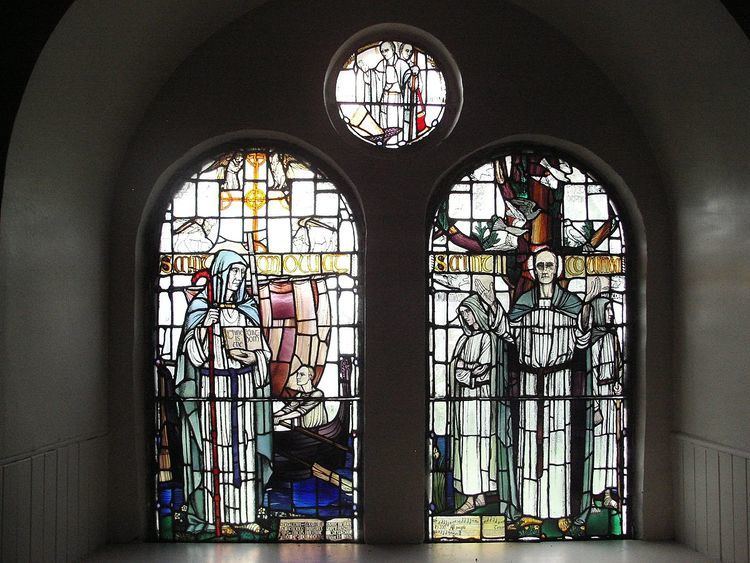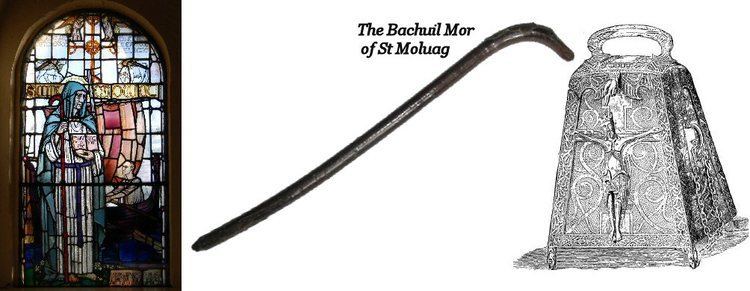Major shrine Isle of Lismore Feast 25 June | Name Saint Moluag Patronage Argyll and Bute | |
 | ||
Venerated in Roman Catholic Church, Anglican Church Died 592 AD, Rosemarkie, United Kingdom | ||
Lismore and the 'Secret' Saint | Dig It! TV
Saint Moluag (c. 510–592; also known as Lua, Luan, Luanus, Lugaidh, Moloag, Molluog, Molua, Murlach, Malew) was a Scottish missionary, and a contemporary of Saint Columba, who evangelized the Picts of Scotland in the sixth century. Saint Moluag was the patron saint of Argyll as evidenced by a charter in 1544, from the Earl of Argyll, which states "in honour of God Omnipotent, the blessed Virgin, and Saint Moloc, our patron". The House of Lorne became the kings of Dalriada and eventually united with the Picts to become the kings of Scots. Moluag was patron saint of the kings of Dalriada, was the apostle of the Picts, so is highly likely to have been the first patron saint of Scotland.
Contents

Life
Saint Lughaidh, better known by his pet name of Moluag, was an Irish noble of the Dál nAraide (one of the main tribes of the Ulaid in what is now called Ulster).
There are various Irish forms of the name, such as Lughaidh (or Lugaid), Luoc and Lua. Latinized they become Lugidus, Lugidius, Lugadius, Lugacius and Luanus. The name, as it has come down the centuries, Moluag or Moluoc, is made up of the honorific mo, plus the original name Lughaidh, pronounced Lua, plus the endearing suffix –oc. Other variants include Lugdach, Malew, Molonachus, Moloc and Molucus.
St. Moluag, the founder of over a hundred monasteries, was a bishop active during the period of the First Order of Celtic Saints and known as ‘The Clear and Brilliant, The Sun of Lismore in Alba’. The First Order were ‘most holy: shining like the sun’. This is a clear reference to his membership of the First Order.
MacDonald suggests that there must have been a Vitae of St. Moluag that is lost because of his prominent appearance in St. Bernard’s Life of Malachy. He writes ‘Further support for this occurs in the Life of Patrick by the Cistercian monk Jocelin of Furness written in circa 1185, where Mo-Luóc (“Lugacius”) is described as one of the six Irish priests whom Patrick prophesied would become bishops’. In a footnote he adds that the five other priests were Columbanus (Cólman), Meldanus (Mellán), Lugadius (Mo Lua), Cassanus (Cassán) and Creanus (Ciarán).
St. Moluag was born between 500 and 520. We know that he was a bishop in about 552 and that he ordained St. Comgal, his close kinsman, initially as a deacon then as a priest. Moluag persuaded St. Comgal to found Bangor Abbey, at Bangor, Ireland in modern-day Ulster.
Having helped St. Comgal set up this abbey, perhaps the greatest of all abbeys of its time, he took the road of white martyrdom and left with twelve followers to lead the life of a missionary. In 562 he founded his great community on the large island of the Lyn of Lorn in Argyll now called the Isle of Lismore, in Loch Linnhe. (Lios mor is ancient Gaelic for ‘great courtyard’ in reference to the monastery).
This had been the sacred island of the Western Picts whose capital was at Beregonium, across the water at Benderloch. Their kings were cremated on the ancient man made ‘burial mound’ of Cnoc Aingeil (Gaelic for ‘Hill of Fire’) at Bachuil, about three miles from the north of the island, near to the site that St. Moluag chose for his first centre.
Lismore was the most important religious spot to the pagan kings of the area. It was therefore the most desirable site for a missionary. Irish missionaries had learnt to focus heavily on the similarity and continuity between early Christianity and Paganism rather than the differences between them. The conversion process was therefore one of gradual education rather than outright confrontation and there were remarkably few martyrs in the area.
MacDonald describes Lismore as being ‘hugely important, being closely tied with one of the earliest and most important Christian Saints in Northern Britain: Mo Luóc, or Moluag.’
Tradition states that the rock on which Moluag stood detached itself from the Irish coast and he drifted across to the island of According to the Irish Annals, in 562 Moluag beat Saint Columba in a race to the large island of the Lyn of Lorn in Argyll.
St. Moluag, a bishop, travelled with St. Comgall, Abbot of Bangor, to obtain sanction for his missions in the land of the Northern Picts from King Brude at Inverness, and Columba, an exiled penitent, was in this party. Dr Reeves, writes that ‘The Life of St. Comgall represents St. Columba as only one of the agents on this occasion’, contradicting Adamnan’s claim that Columba was the leader of the mission. Ian Bradley writes ‘It certainly seems on the best available evidence we now have that Columba does not deserve the accolade of apostle to the Picts. His forays into Pictish territory seem to have been few and far between and it is highly doubtful that he felt any evangelistic impulse to convert particular people to Christianity.’ This supports Smyth’s view that Columba was a saint of the Cenél Loairn and that he rarely ventured out of their territory. St. Moluag was the patron saint of the Cenél Loairn.
It is speculated that King Brude preferred Moluag to Columba because of Columba's close relation to the Gaelic leadership of Dál Riata. Columba could not speak the language of the Picts whereas Moluag was fluent, which could explain why Moluag evangelized largely Pictish areas and Columba stayed within the sphere of Dál Riata influence.
After founding an island monastery on the Isle of Lismore, Moluag went on to found two other great centres in the land of the Picts at Rosemarkie and Mortlach. These were his three centres of teaching, and all three were to become the seats of the Roman Catholic Sees of the Isles, Ross and Aberdeen. It is claimed in the biography of Saint Malachy that Moluag was the founder of 100 monasteries in Dark Ages Scotland.
Moluag died in Rosemarkie, Scotland on 25 June 592. The Annals of Ulster record the death of Lugaid of Les Mór in 592: Obitus Lugide Lis Moer.
Moluag is said to have been buried at Rosemarkie on the Moray Firth, though his remains were later transported to Lismore, and honoured in the cathedral which bore his name.
The Coarb, or successor, of Saint Moluag, is the Livingstone chief of the Clan MacLea. This Livingstone family of Lismore had long been the hereditary abbots of Lismore and, hence, possessors of the crozier of the saint. The bell of Saint Moluag was in existence until the sixteenth century when it disappeared during the Reformation. An ancient bell found at Kilmichael Glassary, Argyll was thought to have been the lost bell.
Veneration as a saint
Saint derives from the Latin word Sanctus, meaning "holy", and is historically reserved in Christian tradition to those whose lives exhibited heroic virtue and sanctity, above and beyond what is ordinary. The feast day of Saint Moluag (25 June) was restored in 1898 by Pope Leo XIII.
He is one of the 48 saints referred to in the Lorrha ("Stowe") Missal used by churches of Ireland, Scotland, Britain, France, Germany, Switzerland, and northern Italy: "Saint Lua of Lismore, Pray for us".
Legacy and dedications
Several churches were dedicated to Saint Moluag, including:
Other sites include churches at Clatt and Tarland, in Aberdeenshire; and also churches on Skye, Mull, Raasay, Tiree, and Pabay. At Alyth in Perth and Kinross the ruins of a church, known today as "The Alyth Arches" were built on the site of an older sixth-century church dedicated to the saint.
At Mortlach in Banffshire, where some of his relics were preserved, an abbey was founded in 1010 by Máel Coluim II of Scotland, in thanks for a victory in which the Scots had invoked the aid of Saint Moluag.
On Lewis Saint Moluag was invoked for cures from madness.
At Clatt there was held annually "St. Mallock's Fair", which lasted eight days. At Tarland there was a "Luoch Fair" which is thought to have been in honour of Saint Molaug, and at Alyth "Simmalogue Fair" was celebrated.
